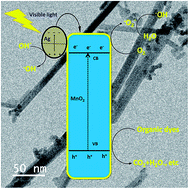Constructing novel Ag nanoparticles anchored on MnO2 nanowires as an efficient visible light driven photocatalyst†
Abstract
In this study, novel Ag@MnO2 nanowires were constructed, using a one step hydrothermal method, which exhibited excellent efficiency towards the photodegradation of organic contaminants under visible-light driven irradiation. The resulting Ag@MnO2 nanowires were systematically characterized using various spectroscopic and microscopic techniques. Morphological characterizations show that the Ag nanoparticles are well anchored on the surface of the MnO2 nanowires. The N2 adsorption/desorption studies revealed that the as prepared photocatalyst possesses mesoporosity. The optical properties and energy band gap structures were studied using UV-visible diffuse reflectance spectroscopy. The photocatalytic activity enhancement of the Ag@MnO2 (5%) nanowires could be ascribed to the efficient separation of the photogenerated electron–hole pairs compared to other Ag@MnO2 nanowires and pure MnO2. The possible photocatalytic mechanism was proposed for this enhanced charge separation performance using photoluminescence spectra analysis, electrochemical impedance spectroscopy (EIS) spectra and photocurrent density. Furthermore, photocatalytic mechanism investigations demonstrate that ˙OH and O2˙− play a key role and h+ plays a minor role in the photocatalytic process. We believe that our findings can open a new avenue for the photocatalytic applications of Ag@MnO2 nanowires.


 Please wait while we load your content...
Please wait while we load your content...